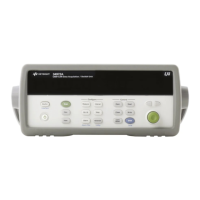7Tutorial
280 Keysight 34970A/34972A User’s Guide
Thermocouple Measurements
A thermocouple converts temperature to voltage. When two wires composed of
dissimilar metals are joined, a voltage is generated. The voltage is a function of
the junction temperature and the types of metals in the thermocouple wire. Since
the temperature characteristics of many dissimilar metals are well known, a
conversion from the voltage generated to the temperature of the junction can be
made. For example, a voltage measurement of a T-type thermocouple (made of
copper and constantan wire) might look like this:
Notice, however, that the connections made between the thermocouple wire and
the internal DMM make a second, unwanted thermocouple where the constantan
(C) lead connects to the internal DMM’s copper (Cu) input terminal. The voltage
generated by this second thermocouple affects the voltage measurement of the
T-type thermocouple.
If the temperature of the thermocouple created at J2 (the LO input terminal) is
known, the temperature of the T-type thermocouple can be calculated. One way
to do this is to connect two T-type thermocouples together to create only
copper-to-copper connections at the internal DMM’s input terminals, and to hold
the second thermocouple at a known temperature.

